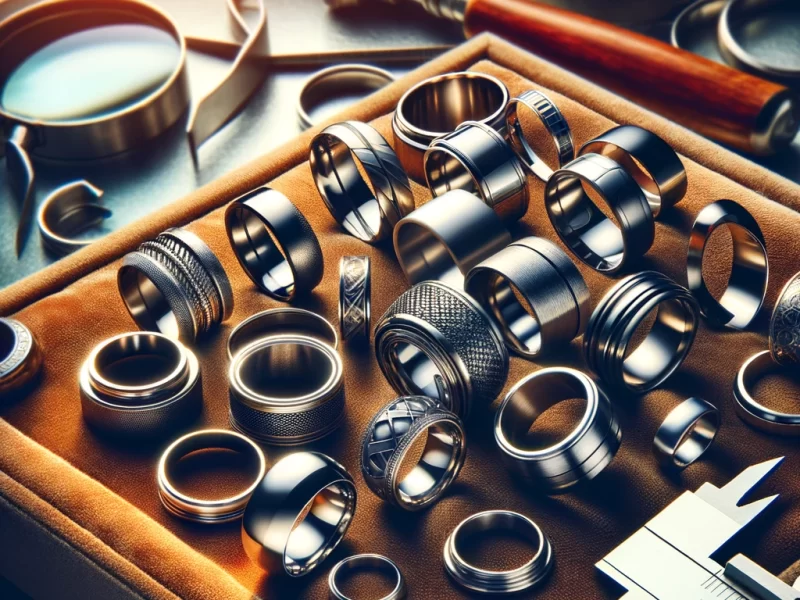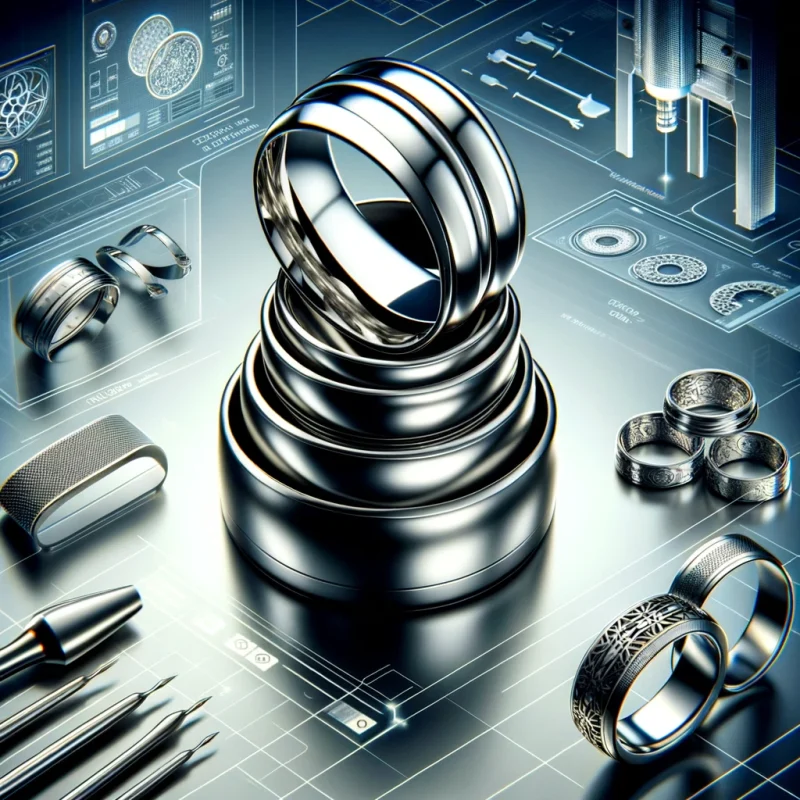
内容目录
Ensuring the quality of stainless steel rings is a crucial aspect of jewelry manufacturing that combines a series of meticulous steps, ranging from the selection of raw materials to the final inspection of finished products. Let’s delve into how manufacturers maintain high standards to deliver durable and aesthetically pleasing stainless steel rings.
Understanding the Material Selection Process
The first step in ensuring the quality of stainless steel rings begins with the selection of the right type of stainless steel. Stainless steel comes in various grades, each suitable for different types of jewelry due to their specific properties like corrosion resistance, durability, and luster. For rings that are worn daily and exposed to various elements, manufacturers typically use 316L stainless steel, known for its superior corrosion resistance and hypoallergenic properties.
Design and Mold Creation
Once the appropriate stainless steel grade is selected, the design process begins. This involves crafting detailed sketches and using CAD (Computer-Aided Design) software to create precise models. These digital designs are then used to make molds or dies, which are crucial for casting or shaping the rings accurately.
Manufacturing Techniques
The manufacturing of stainless steel rings can involve various techniques:
- Casting: Liquid metal is poured into molds to form the ring shapes.
- Die-striking: High pressure is used to stamp the metal into shape, which enhances the density and durability of the rings.
- Machining: This involves cutting and shaping the ring using lathes and CNC machines to achieve precise dimensions and intricate details.
Surface Treatment and Polishing
After shaping the rings, surface treatments are applied to enhance their appearance and resistance to wear. Common treatments include polishing, buffing, and plating with metals like gold, rhodium, or black oxide. These processes not only improve the aesthetic appeal but also add a protective layer against scratches and tarnish.
Quality Control Measures
Quality control is integral at every stage of manufacturing. This includes:
- Material Testing: Ensuring the metal meets specific standards for chemical composition and mechanical properties.
- Dimensional Inspection: Using precision tools to measure the dimensions of the rings to ensure they match the design specifications.
- Visual Inspection: Checking for any surface defects, such as scratches or uneven finishes.
- Durability Testing: Subjecting the rings to conditions that simulate long-term wear to ensure they maintain their integrity and appearance over time.
Final Inspection and Packaging
The final step in the quality assurance process is a comprehensive inspection of each ring before it is packaged and shipped. This final review ensures that only products that meet all quality standards reach the customer. Additionally, effective packaging is crucial to protect the rings during transit and ensure they arrive in pristine condition.
Ongoing Improvements and Customer Feedback
Manufacturers also rely on feedback from customers and ongoing market research to continually improve their products. Adapting to new technologies and customer preferences allows them to stay ahead in the competitive market of stainless steel jewelry.
In summary, the quality assurance of stainless steel rings is a complex process involving meticulous material selection, precise manufacturing, thorough testing, and continuous improvement. This ensures that customers receive products that are not only beautiful but also durable and long-lasting.
Continual Advancements in Production Technology
Advancements in production technology play a significant role in enhancing the quality of stainless steel rings. Modern technologies such as 3D printing and laser cutting are being increasingly incorporated into the manufacturing process. These technologies allow for higher precision in design and can create more complex and detailed shapes that were previously not possible with traditional methods.
Laser Engraving for Customization
Laser engraving is a popular technique used to add personalized touches to stainless steel rings, such as engravings of names, dates, or special symbols. This technology provides precise and clear engravings that enhance the ring’s design without affecting its durability. It’s a perfect blend of personalization and quality, making each piece unique for the customer.
Ethical Sourcing and Sustainability
As consumers become more environmentally conscious, manufacturers are increasingly focusing on ethical sourcing and sustainable practices. This includes using recycled stainless steel and implementing manufacturing processes that reduce waste and energy consumption. Ethical sourcing not only ensures the quality of the rings but also appeals to customers who are mindful of their environmental impact.
Training and Development of Skilled Artisans
Behind every high-quality stainless steel ring is a team of skilled artisans who bring the designs to life. Manufacturers invest in continuous training and development programs to ensure that their artisans are well-versed in the latest jewelry-making techniques and technologies. This ongoing education helps maintain high standards of craftsmanship and innovation in ring production.
Responding to Market Trends
Keeping up with market trends is essential for manufacturers to ensure that their stainless steel rings meet current consumer preferences. This involves regular analysis of fashion trends and consumer feedback, allowing manufacturers to adapt their designs and production processes accordingly. By staying relevant to market demands, manufacturers can ensure a constant improvement in the quality and appeal of their rings.
Building Consumer Trust through Certifications
To further assure quality and build consumer trust, many stainless steel ring manufacturers seek certifications from recognized industry bodies. These certifications, such as ISO 9001 for quality management systems, confirm that the manufacturing processes meet high international standards. Displaying these certifications helps reassure customers about the quality and reliability of the products they are purchasing.
Conclusion
Ensuring the quality of stainless steel rings is a comprehensive process that spans several facets, from raw material selection and advanced manufacturing techniques to ethical sourcing and responsive customer engagement. By adhering to strict quality control measures and staying updated with technological advancements, manufacturers can continue to offer products that not only meet but exceed customer expectations. The result is a product line that is not just durable and beautiful, but also responsibly made and tailored to contemporary consumer needs.
Integration of Artificial Intelligence in Quality Control
Artificial intelligence (AI) is revolutionizing the quality control processes in stainless steel ring manufacturing. AI technologies can automate the inspection of rings for defects such as scratches, uneven finishes, or structural inconsistencies. High-resolution cameras combined with AI algorithms can scan each ring at various production stages to identify defects that are imperceptible to the human eye. This not only speeds up the quality control process but also enhances its accuracy, ensuring that each ring meets the stringent standards expected by consumers.
The Role of Supply Chain Management in Ensuring Quality
The quality of stainless steel rings is not only determined by the manufacturing process but also by how effectively the supply chain is managed. Reliable sourcing of high-quality raw materials is crucial. Manufacturers must maintain strong relationships with suppliers who adhere to high standards of quality and deliver materials consistently without delays. Efficient supply chain management helps in reducing production hitches, maintaining cost-effectiveness, and ensuring that the final product remains of high quality.
Customer-Centric Approaches for Quality Improvement
Manufacturers of stainless steel rings are increasingly adopting customer-centric approaches to improve their product quality. This involves gathering detailed customer feedback through surveys, product reviews, and direct communications. By understanding customer experiences and expectations, manufacturers can make informed improvements not just in product quality but also in customer service practices. These insights help in refining product designs, enhancing functionality, and ensuring that the rings truly meet the evolving needs of end-users.
Advanced Coating Techniques for Enhanced Durability
To further improve the durability and appearance of stainless steel rings, advanced coating techniques are employed. Techniques such as Physical Vapor Deposition (PVD) allow for the application of coatings that are not only aesthetically diverse but also extremely resistant to tarnishing, corrosion, and scratching. These coatings can range in color from classic silvers and golds to more exotic hues such as blues and blacks, providing an array of options for consumers seeking both style and durability.
Global Standards and Compliance
Adhering to global standards and compliance regulations is another crucial aspect of manufacturing high-quality stainless steel rings. Manufacturers must ensure that their products comply with international safety and quality standards such as those set by the American Society for Testing and Materials (ASTM) or the International Organization for Standardization (ISO). Compliance not only helps in maintaining product quality across borders but also builds trust with international customers and partners.
Educational Initiatives and Industry Collaboration
To foster a culture of continuous improvement and innovation, manufacturers often engage in educational initiatives and industry collaborations. Participating in trade shows, workshops, and seminars allows them to stay updated with the latest industry trends, technologies, and best practices. Collaboration with other industry players and academic institutions can also lead to the development of new materials, technologies, and processes that push the boundaries of what is possible in stainless steel ring manufacturing.
Conclusion
The process of ensuring the quality of stainless steel rings is intricate and multifaceted, involving everything from advanced manufacturing techniques to global compliance and customer feedback. By embracing modern technologies, maintaining strong supply chain relationships, and staying committed to continuous improvement, manufacturers can deliver products that are not only of exceptional quality but also aligned with the values and expectations of today’s discerning consumers.
Innovative Packaging Solutions for Stainless Steel Rings
Packaging plays a pivotal role in the quality assurance of stainless steel rings. Innovative packaging solutions not only protect the rings during shipping but also enhance the customer’s unboxing experience. Manufacturers are turning to materials that are both sturdy and visually appealing, such as custom-designed boxes with soft linings that prevent scratches during transit. Additionally, sustainable packaging options, such as recycled paper or biodegradable plastics, are increasingly popular, aligning with global environmental consciousness. These packaging innovations help ensure that the rings arrive in pristine condition and support a brand’s image as environmentally responsible.
Utilizing Big Data for Quality Enhancement
The use of big data analytics is becoming a significant trend in the manufacturing sector, including the production of stainless steel rings. By analyzing large datasets on production processes, customer preferences, and market trends, manufacturers can pinpoint areas for improvement in their production lines and product designs. This data-driven approach allows for more precise adjustments to design and production processes, ultimately leading to higher quality products that better meet customer needs.
Enhancing Quality Through Robotic Automation
Robotic automation is another technological advancement that enhances the quality of stainless steel rings. Robots can handle repetitive tasks with high precision and consistency, such as polishing and engraving, which are critical for achieving flawless finishes. The integration of robotics in the manufacturing process not only improves the quality and consistency of the rings but also increases production efficiency and reduces human error.
Strategic Vendor Management for Raw Material Excellence
Maintaining high standards for stainless steel rings starts with the raw materials used. Strategic vendor management involves selecting suppliers who provide high-grade stainless steel and other materials that meet strict specifications. Manufacturers often conduct audits and maintain ongoing communication with suppliers to ensure that the raw materials supplied consistently meet quality standards. This close relationship helps prevent issues like material shortages and quality variances, which can affect production schedules and final product quality.
Continuous Training and Skills Development
Continuous training and skills development for employees are crucial for maintaining high-quality production of stainless steel rings. Manufacturers invest in regular training programs to ensure that their workforce is skilled in the latest manufacturing technologies and quality control practices. This ongoing training helps workers stay adept at using new equipment and techniques, which is essential for producing high-quality rings and adapting to new market demands.
Conclusion
The journey to ensuring the quality of stainless steel rings is comprehensive and involves a synergy of advanced technologies, skilled craftsmanship, strategic supply chain management, and innovative customer engagement strategies. By focusing on these areas, manufacturers not only enhance the quality of their products but also ensure sustainability and customer satisfaction. This holistic approach to quality assurance positions manufacturers to meet the high expectations of today’s markets and maintain a competitive edge in the jewelry industry.


